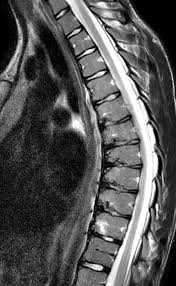Scheuermann’s Disease (SD)
Scheuermann’s disease is the most common cause of adolescent structural kyphosis (too much curvature of the thoracic spine – a spine deformity). The thoracic spine is the section below the neck to the bottom of the rib cage. A less common form of this disease can affect the thoracic and lumbar spine. The diseases cause the spine and spinal discs to grow at abnormal rates.
This disease is often mistaken for poor posture. Scheuermann’s disease begins in childhood and affects up to 8% of children between the ages of 10 and 12. It develops before puberty and progresses during growth spurts throughout adolescence. SD is twice as common in boys than girls and progresses until growth is complete. The disease can range from mild to severe.
What are the symptoms?
The earliest signs are a forward head position, rounded shoulders and limited shoulder motion. The adolescent cannot correct their posture. The most common complaint of children with SD is a self-perceived negative body image due to the hump created by the deformity. Adolescence is a time for ‘fitting in. A negative body image is likely to involve worry, concerns about fitting in and relationships at this most vulnerable time.
As the disease progresses other symptoms may include tight hamstrings, back pain, fatigue, muscle stiffness, spinal rigidity, decreased flexibility, weakness, numbness and tingling in the legs, loss of sensation and shortness of breath.
Pain is typically not severe and is triggered by long periods of sitting or exercise but resolves when growth ends. However, it can produce severe pain and physical and psychological disability. Affected adolescents also often have scoliosis.
What causes Scheuermann’s disease?
This disease is the result of a structural abnormality of the vertebrae in the upper spine caused by abnormal growth of the vertebrae during puberty. The true cause is not clear, but includes a combination of genetics, metabolic factors, poor bone quality, hormones, and mechanical factors.
Diagnosis
Scheuermann’s disease is diagnosed based on the magnitude of the curvature. The normal curvature of the upper spine is between 200 and 450. Curvature greater than this is characteristic of SD.
Dr. Shufflebarger will take a complete medical history, discuss your child’s symptoms and general health, and conduct a thorough physical examination including some common tests to evaluate how the condition affects the child’s balance, flexibility and range of motion. He will order x-rays to view the structure of the vertebrae and confirm the diagnosis. X-rays will reveal the structural deformity of the vertebra and spine. When there is severe curvature, he will order other tests to evaluate lung and heart function.
Treatment options
Patients with mild disease can be successfully treated with nonsurgical observation, anti-inflammatory medications and physical therapy. Bracing may be helpful, but compliance is difficult. Surgery is indicated for children with severe curvature, intractable pain, neurological deficits, compromised heart and lungs function and disfigurement.
Dr. Harry Shufflebarger is a world-renowned pediatric spine surgeon and the chief of spinal surgery at the Nicklaus Children’s Hospital in Miami, Florida. He is one of the top ten pediatric spine surgeons in the United States. He and his team of experts are specially trained and experienced in the unique needs of children with complex conditions. In addition to his many accomplishments in research and innovation in pediatric spine conditions, Dr. Shufflebarger is a kind and compassionate doctor who is sought out by parents the world over.


